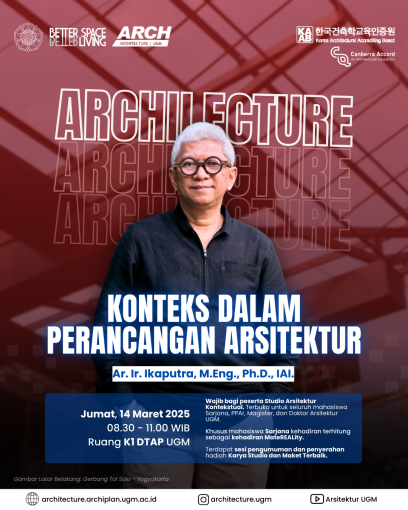
(Yogyakarta, March 14, 2025) – In the world of architecture, building design is not only about aesthetics and function but must also consider the surrounding environmental context. Architects and designers today increasingly emphasize the importance of understanding social, cultural, economic, and natural aspects in every project they undertake.
In this Archilecture session, students gained a deeper understanding of architectural context with UGM Architecture lecturer, Ar. Ir. Ikaputra, M.Eng., Ph.D., IAI. Held in Room K1 of the Department of Architecture and Planning, Faculty of Engineering, UGM, the discussion covered various aspects that influence building design, such as climate conditions, the history of an area, and the needs of the local community. A good design should not only possess aesthetic value but also integrate with its surroundings and respond effectively to local challenges.
For example, in designing residences in tropical regions like Indonesia, the use of materials suited to the climate is crucial. Utilizing natural ventilation, roofs that can withstand heat, and locally sourced building materials are key strategies for creating comfortable and energy-efficient buildings.
Beyond environmental factors, social and cultural aspects also play a crucial role. Architectural designs that take into account local traditions and wisdom tend to be more widely accepted by the community. This is evident in various development projects for tourist areas and residential neighborhoods that incorporate traditional architectural elements while integrating modern technology.
In the era of sustainability, a context-based approach has become a major focus. The concept of green architecture and environmentally friendly buildings is now widely applied to reduce negative impacts on the environment. The use of renewable energy, efficient water management, and designs that support natural air circulation are essential aspects of creating sustainable buildings.
With growing awareness of the importance of context in architectural design, future developments are expected to be more in harmony with the environment and human needs. Context-based architecture will not only benefit its occupants but also the surrounding ecosystem and culture.
With the increasing awareness of the importance of context in architectural design, future developments are expected to align better with the environment and human needs. Context-based architecture will not only provide benefits for its inhabitants but also for the surrounding ecosystem and culture. Therefore, the role of architects and designers in comprehensively understanding and applying context is key to creating an environment that is not only aesthetically pleasing but also functional and sustainable. This aligns with the values in SDG 9: Industry, Innovation, and Infrastructure, as well as SDG 11: Sustainable Cities and Communities.
(Reported and written by Kheisya Nabila Zahra)





